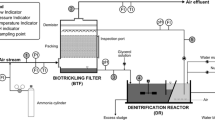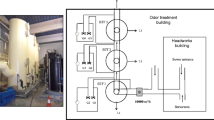Abstract
Polluted air streams can be purified using biological treatments such as biotrickling filtration, which is one of the most widely accepted techniques successfully tuned to treat a wide variety of exhausted gaseous streams coming from a series of industrial sectors such as food processing, flavor manufacturers, rendering, and composting. Since the degradation of a pollutant occurs at standard pressure and temperature, biotrickling filtration, whether compared with other more energy-demanding chemical-physical processes of abatement (such as scrubbing, catalytic oxidation, regenerative adsorption, incineration, advanced oxidation processes, etc.), represents a very high energy-efficient technology. Moreover, as an additional advantage, biodegradation offers the possibility of a complete mineralization of the polluting agents. In this work, biotrickling filtration has been considered in order to explore its efficiency with respect to the abatement of ammonia (which is a highly water-soluble compound). Moreover, a complete mathematical model has been developed in order to describe the dynamics of both absorption and biological activities which are the two dominant phenomena occurring into these systems. The results obtained in this work have shown that the absorption phenomenon is very important in order to define the global removal efficiency of ammonia from the gaseous stream (particularly, 44% of the ammonia is abated by water absorption). Moreover, it has been demonstrated (through the comparison between experimental results and theoretical simulations) that the action of bacteria, which enhance the rate of ammonia transfer to the liquid phase, can be modeled through a simple Michaelis-Menten relationship.







Similar content being viewed by others
Abbreviations
- a :
-
Specific area, m2/m3
- C :
-
Constant 1 in Michaelis-Menten Eq. (18), kmol/(m3 s)
- c :
-
Molar concentration, kmol/m3
- D :
-
Packing material diameter, m
- G :
-
Gas flow rate, m3/s
- H :
-
Henry’s constant, (kmol/(m3 s Pa) height, m
- K :
-
Pressure Drop Factor, (m2 s)/kg global material transfer constant, kmol / (s m2 Pa)
- k :
-
Material transfer constant, kmol / (s m2 Pa)
- L :
-
Liquid flow rate, m3/s
- P :
-
Pressure, Pa
- R :
-
Ideal gas constant, J/(kmol K) absorption or biological reaction rate, kmol/(m3 s)
- S :
-
Constant 2 in Michaelis-Menten Eq. (18), kmol/(m3 s)
- T :
-
Temperature, K
- t :
-
Time, s
- V :
-
Volume, m3
- v :
-
Velocity, m/s
- x :
-
Horizontal direction
- y :
-
Molar fraction in gaseous phase, − Transverse direction
- z :
-
Vertical direction
- AIR :
-
Referred to as the air pseudo-species
- abs :
-
Referred to absorption
- aq :
-
Referred to as the aqueous phase
- atm :
-
Referred to the atmospheric pressure
- bio :
-
Referred to biological activity
- C :
-
Referred to the column height
- eq :
-
Referred to the equilibrium conditions
- free :
-
Referred to as the tap water
- g :
-
Referred to as the gas phase
- in :
-
Referred to inlet conditions
- l :
-
Referred to as the liquid phase
- lb :
-
Referred to as lbmol units
- NH 3 :
-
Referred to as the ammonia species
- z :
-
Along the vertical direction
- +:
-
Referred to upper side of the right boundary
- −:
-
Referred to lower side of the left boundary
- ε :
-
External void fraction, −
- μ :
-
Viscosity, Pa s
- ℘:
-
Material diffusivity, m2/s
References
Busca G, Pistarino C (2003) Abatement of ammonia and amines from waste gases: a summary. J Loss Prev Process Ind 16:157–163
Casson Moreno V, Cozzani V (2015) Major accident hazard in bioenergy production. J Loss Prev Process Ind 35:135–144
Casson Moreno V, Papasidero S, Scarponi GE, Guglielmi D, Cozzani V (2016) Analysis of accidents in biogas production and upgrading. Renew Energy 96:1127–1134
Copelli S, Torretta V, Raboni M, Viotti P, Luciano A, Mancini G, Nano G (2012) Improving biotreatment efficiency of hot waste air streams: experimental upgrade of a full plant. Chem Eng Trans 30:49–54
Den W, Huang C, Li CH (2004) Effects of cross-substrate interaction on biotrickling filtration for the control of VOC emissions. Chemosphere 57(7):697–709
Hahne J, Vorlop KD (2004) Are waste air scrubbers useful in reducing ammonia emissions from piggeries? Landtechnik 59:106–107
Hernroth B, Baden S, Tassidis H, Hörnaeus K, Guillemant J, Bergström Lind S, Bergquist J (2016) Impact of ocean acidification on antimicrobial activity in gills of the blue mussel (Mytilus edulis). Fish Shellfish Immunol 55:452–459
Juhler S, Revsbech NP, Schramm A, Herrmann M, Ottosen LDM, Nielsen LP (2009) Distribution and rate of microbial processes in an ammonia-loaded air filter biofilm. Appl Environ Microbiol 75:3705–3713
Koops HP, Pommerening-Röser A (2001) Distribution and ecophysiology of the nitrifying bacteria emphasizing cultured species. FEMS Microbiol Ecol 37:1–9
Krupa SV (2003) Effects of atmospheric ammonia (NH3) on terrestrial vegetation: a review. Environ Pollut 124:179–221
Lafita C, Penya-Roja JM, Gabaldón C, Martínez-Soria V (2012) Full-scale biotrickling filtration of volatile organic compounds from air emission in wood-coating activities. J Chem Technol Biotechnol 87(6):732–738
Lu C, Lin MR, Lin J (2001) Removal of styrene vapor from waste gases by a trickle-bed air biofilter. J Hazard Mater 82:233–245
Mathur AK, Majumder CB (2008) Biofiltration and kinetic aspects of a biotrickling filter for the removal of paint solvent mixture laden air stream. J Hazard Mater 152:1027–1036
Melse RW, Ploegaert JPM, Ogink NWM (2012) Biotrickling filter for the treatment of exhaust air from a pig rearing building: ammonia removal performance and its fluctuations. Biosyst Eng 113:242–252
Morotti K, Ramirez AA, Jones JP, Heitz M (2011) Analysis and comparison of biotreatment of air polluted with ethanol using biofiltration and biotrickling filtration. Environ Technol 32(16):1967–1973
Orrington ED, Barnett FD (1941) Rate of absorption of ammonia by water in a packed tower. Ind Eng Chem 33:485–492
Ottosen LDM, Juhler S, Guldberg LB, Feilberg A, Revsbech NP, Nielsen LP (2011) Regulation of ammonia oxidation in biotrickling filters with high ammonium load. Chem Eng J 167:198–205
Pérez MC, Álvarez-Hornos FJ, Engesser KH, Dobslaw D, Gabaldón C (2016) Removal of 2-butoxyethanol gaseous emissions by biotrickling filtration packed with polyurethane foam. New Biotechnol 33(2):263–272
Saucedo-Lucero JO, Marcos R, Salvador M, Arriaga S, Muñoz R, Quijano G (2014) Treatment of O2-free toluene emissions by anoxic biotrickling filtration. Chemosphere 117(1):774–780
Scarponi GE, Guglielmi D, Casson Moreno V, Cozzani V (2015) Risk assessment of a biogas production and upgrading plant. Chem Eng Trans 43:1921–1926
Shareefdeen Z, Singh A (2004) Biotechnology for odor and air pollution control. Heidelberg: Springer, New York, USA
Xue N, Wang Q, Wu C, Zhang L, Xie W (2010a) Enhanced removal of NH3 during composting by a biotrickling filter inoculated with nitrifying bacteria. Biochem Eng J 51:86–93
Xue N, Wang Q, Wu C, Sun X, Xie W (2010b) A pilot field-scale study on biotrickling filter treatment of NH3-containing odorous gases from organic waste composting plants. J Zhejiang Univ Sci Appl Phys Eng 11:629–637
Ying-Chien C, Chihpin H, Ching-Ping T (1997) Biotreatment of ammonia from air by an immobilized Arthrobacter oxydans CH8 biofilter. Biotechnol Prog 13:794–798
Acknowledgements
The authors wish to acknowledge AirClean (Rho, Milan, Italy) for its technical support and Anna Valente and Maria Chiara Acerno for their support in the experimental activities.
Author information
Authors and Affiliations
Corresponding author
Ethics declarations
Conflict of interest
The authors declare that they have no conflict of interests.
Additional information
Responsible editor: Marcus Schulz
Rights and permissions
About this article
Cite this article
Copelli, S., Raboni, M., Derudi, M. et al. Comparison between absorption and biological activity on the efficiency of the biotrickling filtration of gaseous streams containing ammonia. Environ Sci Pollut Res 24, 23207–23218 (2017). https://doi.org/10.1007/s11356-017-9968-3
Received:
Accepted:
Published:
Issue Date:
DOI: https://doi.org/10.1007/s11356-017-9968-3




